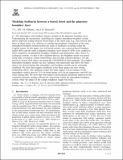Files in this item
Modeling feedbacks between a boreal forest and the planetary boundary layer
Item metadata
| dc.contributor.author | Hill, T. C. | |
| dc.contributor.author | Williams, M. | |
| dc.contributor.author | Moncrieff, J. B. | |
| dc.date.accessioned | 2012-03-06T12:01:02Z | |
| dc.date.available | 2012-03-06T12:01:02Z | |
| dc.date.issued | 2008-08-12 | |
| dc.identifier | 17178847 | |
| dc.identifier | 2e726b8c-9270-41fb-8c72-049034074e80 | |
| dc.identifier | 000258510500001 | |
| dc.identifier | 71949083002 | |
| dc.identifier.citation | Hill , T C , Williams , M & Moncrieff , J B 2008 , ' Modeling feedbacks between a boreal forest and the planetary boundary layer ' , Journal of Geophysical Research , vol. 113 , D15122 , pp. - . https://doi.org/10.1029/2007JD009412 | en |
| dc.identifier.issn | 0148-0227 | |
| dc.identifier.uri | https://hdl.handle.net/10023/2407 | |
| dc.description | T.C.H. was funded by a NERC Studentship at the Centre for Terrestrial Carbon Dynamics. | en |
| dc.description.abstract | The atmosphere and biosphere interact strongly in the planetary boundary layer. Understanding the mechanisms controlling the coupled atmosphere-biosphere system allows improved scaling between observations at the stand scale ( e. g., flux towers) and those at larger scales, e. g., airborne or satellite measurements. Simulation of the joint atmosphere-biosphere system permits the study of feedbacks occurring within the coupled system. In this paper, two well-tested models, one a process-based biosphere model ( SPA) and the other a planetary boundary layer model ( CAPS), were coupled to allow simulation of atmosphere-biosphere feedbacks and interactions with a focus on ecological controls. As part of the validation process, the biosphere model was tested using eddy covariance, surface meteorology, and soil data collected during a 120 day period at a boreal black spruce site during the 1994 BOREAS field campaign. The coupled atmosphere-biosphere model was also validated with radiosonde data above the black spruce site, demonstrating that atmosphere and biosphere models can be coherently combined. We show that negative feedbacks at the black spruce site have strong moderating effects. The feedbacks reduce the mean impact of LAI changes on the atmospheric surface layer by 21% for latent energy, 64% for air temperature, and 44% for water mixing ratio. We show that both radiative and hydraulic limitations imposed by the vegetation structure strongly affected the interactions within the atmosphere-biosphere system, while the impact of the canopy roughness length was weak. | |
| dc.format.extent | 15 | |
| dc.format.extent | 735398 | |
| dc.language.iso | eng | |
| dc.relation.ispartof | Journal of Geophysical Research | en |
| dc.subject | Surface parameterization schemes | en |
| dc.subject | Land-surface | en |
| dc.subject | Black spruce | en |
| dc.subject | Stomatal conductance | en |
| dc.subject | Hydraulic-properties | en |
| dc.subject | Flux measurements | en |
| dc.subject | Eddy covariance | en |
| dc.subject | Climate-change | en |
| dc.subject | Water-balance | en |
| dc.subject | Canopy | en |
| dc.subject | GE Environmental Sciences | en |
| dc.subject | SDG 13 - Climate Action | en |
| dc.subject.lcc | GE | en |
| dc.title | Modeling feedbacks between a boreal forest and the planetary boundary layer | en |
| dc.type | Journal article | en |
| dc.contributor.institution | University of St Andrews. Earth and Environmental Sciences | en |
| dc.identifier.doi | https://doi.org/10.1029/2007JD009412 | |
| dc.description.status | Peer reviewed | en |
This item appears in the following Collection(s)
Items in the St Andrews Research Repository are protected by copyright, with all rights reserved, unless otherwise indicated.

